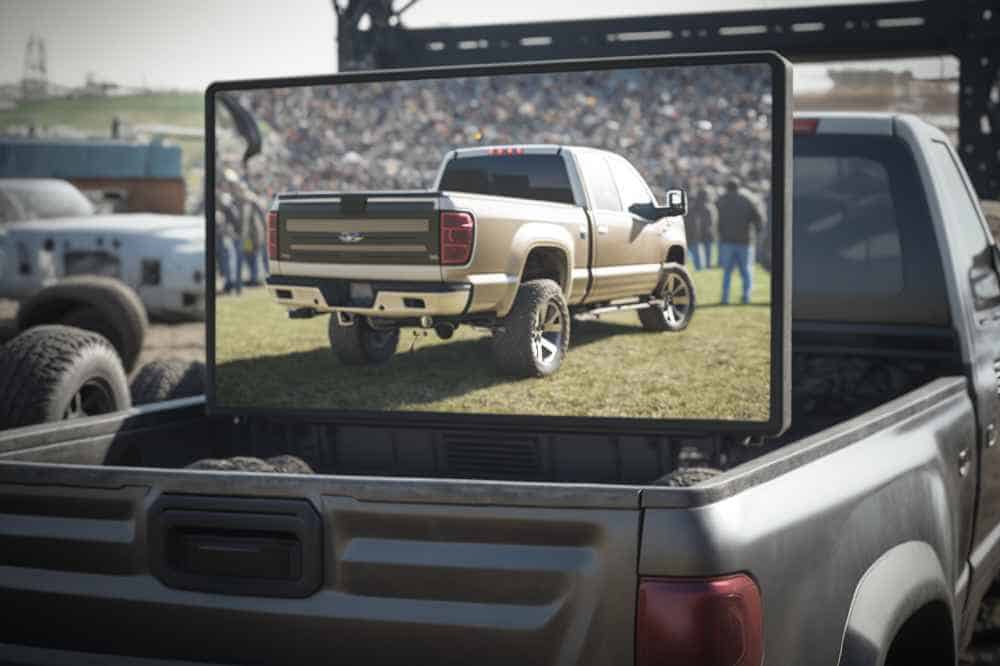Last Updated on April 21, 2023 by Rod Olivares

Powering a TV at a tailgate might be costly if you don’t know what you are doing and how to do it efficiently. Although various alternatives are available, determining the cheapest and most practical way may take time and effort.
The cheapest way to power a TV at a tailgate is to use a car battery and a power inverter. Most tailgaters already have a car battery, so an inverter is the only additional equipment needed. Nevertheless, this may not be practical for extended periods due to noise and mobility.
Read on to learn the most cost-effective methods to watch TV at a tailgate, considering issues like power supply, wattage needs, cost, safety, noise, and mobility.
Considerations for Powering a TV at Tailgate
There are the four primary considerations for powering a TV during tailgate parties.
Type of Power Source
You will need to decide what is the best power source for tailgating, the type of power supply required for your unique situation, and how to get electricity at a tailgate party. There are various options, including vehicle batteries and portable and solar-powered generators. You must weigh your preferences and financial constraints while deciding between the two options.
TV Wattage Needs
Determine the power requirements of your smart TV set. This measure will help you calculate your power needs and zero in on the optimal power supply. Check the TV manufacturer’s specifications to be sure, although often 100 to 300 watts of power is the most common.
Cost
Think about the cost of keeping the TV on at the tailgate. This factor includes not just the fuel efficiency or energy needed to generate the power but also the cost of the power source itself, including any necessary accessories or connections. Consider these things to make an educated choice on the cheapest way to power a TV at a tailgate.
Internet Access
Power your TV with the internet using your cell phone or a mobile hotspot if you are away from a wall outlet. Streaming football games is no problem thanks to the unlimited data plans offered by several major cell phone companies. Just make sure your signal is good where you want to do your tailgating.
It’s possible that an over-the-air antenna may pick up local channels where you’re tailgating. If you don’t want to use your phone or a mobile hotspot to go online, this is a fantastic alternative. You’ll need either a TV with a built-in tuner or a digital converter box to get these channels.
Cheapest Ways to Power a TV at Tailgate
These are the cheapest ways to power a TV at your tailgate.
Option 1: Using a Car Battery and Power Inverter
Using a vehicle’s battery and power inverter is one of the cheapest methods to power a TV at a tailgate—the TV links to an inverter, which subsequently connects to a vehicle battery.
The car’s battery supplies direct current, but a power inverter converts it into alternating current, which may power the TV. Choose an inverter with at least 300 watts of power output to ensure it can handle the TV’s power demands. Before going for the tailgate, ensure you completely charge the car battery.
Also ensure to bring a satellite dish. Satellite dishes come in different sizes and types, but the most convenient one for tailgating is the portable satellite dish. These dishes are designed to be lightweight and easy to set up, making them perfect for outdoor use like tailgating. One of the most popular portable satellite dishes on the market is the DISH Tailgater.
You will need HDMI cables to connect the TV to the inverter and the inverter to the vehicle battery. A surge protector may also be required to protect your TV from power spikes.
Remember that the cost of petrol to recharge the vehicle battery will vary based on the kind of automobile you have and the distance you need to go.
Option 2: Using a Portable Generator
Portable inverter generators are another inexpensive alternative to power a TV at the tailgate. You can find a few of our top recommended choices for best generators for tailgating here. Portable generators are available in several sizes and power outputs, allowing you to utilize one that meets the wattage needs of your television. Portable generators run on gasoline, propane, or diesel fuel and are available at most outdoor equipment shops.
Choose a portable size generator with adequate power output to fulfill the wattage needs of your TV. A 2000-watt generator, for example, should be plenty for most televisions. Gasoline, propane, or diesel fuel will need to be purchased as fuel for your generator, depending on the model you choose.
Bring HDMI cables to connect the TV to the generator and any other equipment needed to safeguard the TV from power fluctuations.
The cost of utilizing a generator to run a TV during a tailgate party might vary greatly depending on the size and kind of generator needed. The cost of gasoline is another consideration; this will change based on the kind of fuel you use and the duration of the operation.
Option 3: Using a Solar-Powered Generator
To be more environmentally conscious, use a solar-powered generator to power your TV at the tailgate. Solar-powered generators run on sunlight and do not need any fuel to function. They are also usually quieter than portable generators and emit no pollutants.
Search for a generator with adequate power output to match the wattage needs of your television. Utilize solar panels to charge the battery of the generator. You must set the solar panels properly so that they get the most sunshine throughout the day.
In addition to the generator, you will need cables to connect the TV to it. Anything else you may need might be a surge protector to keep the TV safe from power fluctuations.
Here’s a table that compares the advantages and disadvantages of each power source:
| Power Source | Pros | Cons |
| Car Battery and Power Inverter | Low initial cost
Quiet operation No fuel consumption |
Limited runtime
Requires a vehicle to recharge a battery May not be powerful enough for larger TVs |
| Portable Generator | Unlimited runtime,
Have enough power for larger TVs Portable |
High initial cost
Noisy operation Emits exhaust fumes Requires fuel May not be allowed in some areas |
| Solar-Powered Generator | Quiet operation
No fuel consumption Environmentally friendly |
High initial cost
Limited runtime (if not a hot day) May not be powerful enough for larger TVs |
Other Considerations When Powering a TV at Tailgate
In addition to financial considerations, there are various additional aspects to consider while powering a TV at a tailgate. They include things like safety, loudness, and portability.
Safety
Observing safety standards while utilizing any power source to avoid harm or damage is critical. For example, when utilizing a portable generator, ensure it is on a flat, level surface and away from any flammable items. If you’re utilizing a vehicle battery and a power inverter, ensure the connections are secure, and the battery isn’t damaged.
Noise
Portable generators, for example, may be pretty loud. Consider utilizing a quieter power source, such as a solar-powered generator, vehicle battery, and power converter, if you are tailgating in a congested tailgate spot.
Portability
Consider how easy it will be to transfer to and from the tailgate when selecting a power supply. Portable generators may be big and bulky, but solar-powered and automobile batteries are lighter and more portable. For streaming portability and if you don’t have a car WiFi, connecting your TV to the nearest WiFi network is also a simple solution for watching the big game while tailgating.
Conclusion
The least expensive option for you to stream TV at a tailgate is a vehicle battery and an electric inverter, although this setup may only suit some operations. One alternative is to use a portable generator, which makes a lot of noise and refuels. Solar-powered generators are more costly but better for the environment than fossil fuel.
If you consider these factors and choose the most awesome option for watching TV, you may enjoy the next tailgate with friends and family while watching the pre-game or Super Bowl.

Scott Krager purchased generatorgrid.com in the summer of 2020 and quickly began to buy every generator under the sun! He currently has over a dozen generators and the number is growing quickly. He lives in Portland, OR near his family and friends.
GeneratorGrid.com is an independent review business. I am not affiliated with any manufacturers and do not accept paid reviews. When you buy through my links, I may earn a commission which helps me purchase more generators for testing. - Scott Krager

